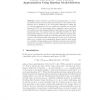230 search results - page 20 / 46 » XCS with computed prediction for the learning of Boolean fun... |
EMNLP
2007
13 years 10 months ago
2007
This paper provides an algorithmic framework for learning statistical models involving directed spanning trees, or equivalently non-projective dependency structures. We show how p...
CVPR
2011
IEEE
13 years 4 months ago
2011
IEEE
Visual attributes expose human-defined semantics to object recognition models, but existing work largely restricts their influence to mid-level cues during classifier training....
FOCS
1999
IEEE
14 years 1 months ago
1999
IEEE
This paper connects two fundamental ideas from theoretical computer science: hard-core set construction, a type of hardness amplification from computational complexity, and boosti...
EUSFLAT
2003
13 years 10 months ago
2003
In the paper, a new optimal learning algorithm for a neo-fuzzy neuron (NFN) is proposed. The algorithm is characteristic in that it provides online tuning of not only the synaptic...
PKDD
2009
Springer
14 years 3 months ago
2009
Springer
Abstract. Feature selection in reinforcement learning (RL), i.e. choosing basis functions such that useful approximations of the unkown value function can be obtained, is one of th...

